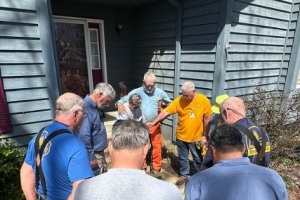New Barna Report Explores Teens and the Supernatural
The Barna Group released a report that examines teens’ media exposure to the supernatural world as well their perception, experience, and beliefs on the immaterial realm.
The Barna Group released a report that examines teens’ media exposure to the supernatural world as well their perception, experience, and beliefs on the immaterial realm.
Ministry to Mosaics: Teens and the Supernatural was released last Tuesday and is based upon three nationwide studies conducted among more than 4,000 teens ages 13 to 18. The report hopes to help youth workers, pastors, and parents understand and respond to the spiritual needs of America’s youth when it comes to this ministry subject.
The 47-page report revealed that most teens believe in the supernatural realm with seven million teens having encountered an angel, demon, or some other supernatural being. According to the Barna research, 30 percent of all teens claim they had supernatural encounters. More than 10 percent of teens say they have communicated with the dead and nearly 10 percent of youth claim they have psychic powers.
Studies by The Barna Group also showed that nearly three-quarters of America’s youth (73 percent) have engaged in at least one type of psychic or witchcraft-related activity beyond media exposure or horoscope usage. The most common named were using an Ouija board and reading a book about witchcraft or Wicca – each of these activities were done by more than one-third of teenagers.
According to The Barna Group, the research revealed that many churches fail to address the subject of the supernatural in terms of time given to the subject and relevance. One of the most striking findings according to the group is that only one-quarter of churched teenagers (28 percent) recall receiving any teaching at their church in the last year that helped to shape their views on the supernatural world.
The report also found that relationally isolated teenagers and those experiencing a significant amount of stress and frustration were more likely to experiment with supernatural activities. For instance, many teens try witchcraft or psychic activities based on a desire to control or influence their situation, according to The Barna Report. Teens with few friends or undergoing intense stress were more likely than average to turn to witchcraft or to psychic power to cope with their feelings of vulnerability and insignificance.
On the other hand, possessing an evangelical faith was by far the most significant factor in keeping teenagers from unwanted exploration of the supernatural. Evangelical teens were nearly three times less likely than the norm to have engaged in witchcraft or psychic activities. While only 26 percent of evangelical have experimented, the next least-likely segment of teens – those who read the Bible at least weekly – showed an engagement rate of 54 percent.
Evangelicals (26 percent) are also significantly less likely to experiment with the supernatural than non-evangelical teens (69 percent), youth group attendees (66 percent), Catholics (77 percent), mainline Protestants (81 percent), Baptists (60 percent), and non-mainline Protestants (62 percent).
An analysis on teens’ beliefs on the supernatural revealed confusion, doubt, and conflicts in what they believe. For instance, although three-quarters believe in the existence of an immaterial, spiritual world, there is little agreement on the topic; almost half think there are good and evil powers, one-fifth says there is no such thing as good versus evil, one out of ten offered some other opinion, and one-quarter said they had no idea.
The following are the highlights on teens’ ideas about the supernatural:
• Most teens embraced the biblical position on life after death: “Every person has a soul that will live forever, either God’s presence or absence” (82 percent). However, a smaller proportion (61 percent) believes Heaven is a real place or paradise where people go when they die.
• Most teenagers (71 percent) embrace the orthodox Christian view of God (the all-powerful, all-knowing, perfect Creator of the world). A slight majority (58 percent) say that Satan is a real spiritual being and the enemy of God.
• Teens have mixed perspectives on other supernatural beings, such as angels, ghosts, demons, witches and vampires. When pressed on the matter, large proportions of teens say they are not very certain of their views on these subjects – even among the 89 percent who believe in the existence of angels.
David Knnaman, author of the report and vice president of The Barna Group concluded the report with a final chapter with recommendations and suggestions including the following excerpt:
“Everyone wants a simple solution,” Kinnaman explained. “Unfortunately, we discovered the answers are quite complex. Teens need help becoming wiser consumers of media, but that takes a long-term, intensive process of coaching. They would also benefit from more integration of Scriptural perspectives into their decision-making – that is, they need to operate on the basis of a biblical worldview.
“But that takes years to develop, immense effort, and close cooperation between church and home,” he continued. “Youth ministries need to address the supernatural more frequently as well as customize their ministry to each student by providing mentoring and personalized development opportunities, but most youth groups would have to be restructured to accomplish these goals. These types of strategies yield deep, whole-life results. But it is difficult to adopt these alternatives because they take patience, prayer and an intense focus on transformed lives rather than mere program attendance.”
According to Kinnaman, the “Mosaic generation” – the term he uses for Americans age three to 21 – is in “a state of spiritual turmoil.”
“They long for personal meaning and they are comfortable with incredible technological and media-driven tools that would enable them to accomplish whatever spiritual goals they choose,” he said. “But millions of teens are precariously close to simply shelving the Christian faith as irrelevant, uninspiring, and ‘just a phase.’ Millions of previously churched Busters ended up rejecting Christian spirituality after high school. Mosaics are in even greater danger of making that leap from faith to doubt.
“The supernatural world represents the epicenter of the spiritual struggle for their hearts and minds,” Kinnaman continued. “When teenagers settle for cheap alternatives instead of choosing intimacy with God – and relying upon His care and His power – it can lead to years, even decades, of spiritual entrapment in their lives. But with appropriate choices come spiritual rewards. After Jesus rejected Satan’s temptations, His ministry flourished. If Mosaics reject spiritual deception and stop tinkering with contemptible imitations of God’s power, it could spell the difference between a generation fulfilling its spiritual destiny and one that turns from God during adulthood.”
For more information about the report or for definitions of terms visit:
www.barna.org





























